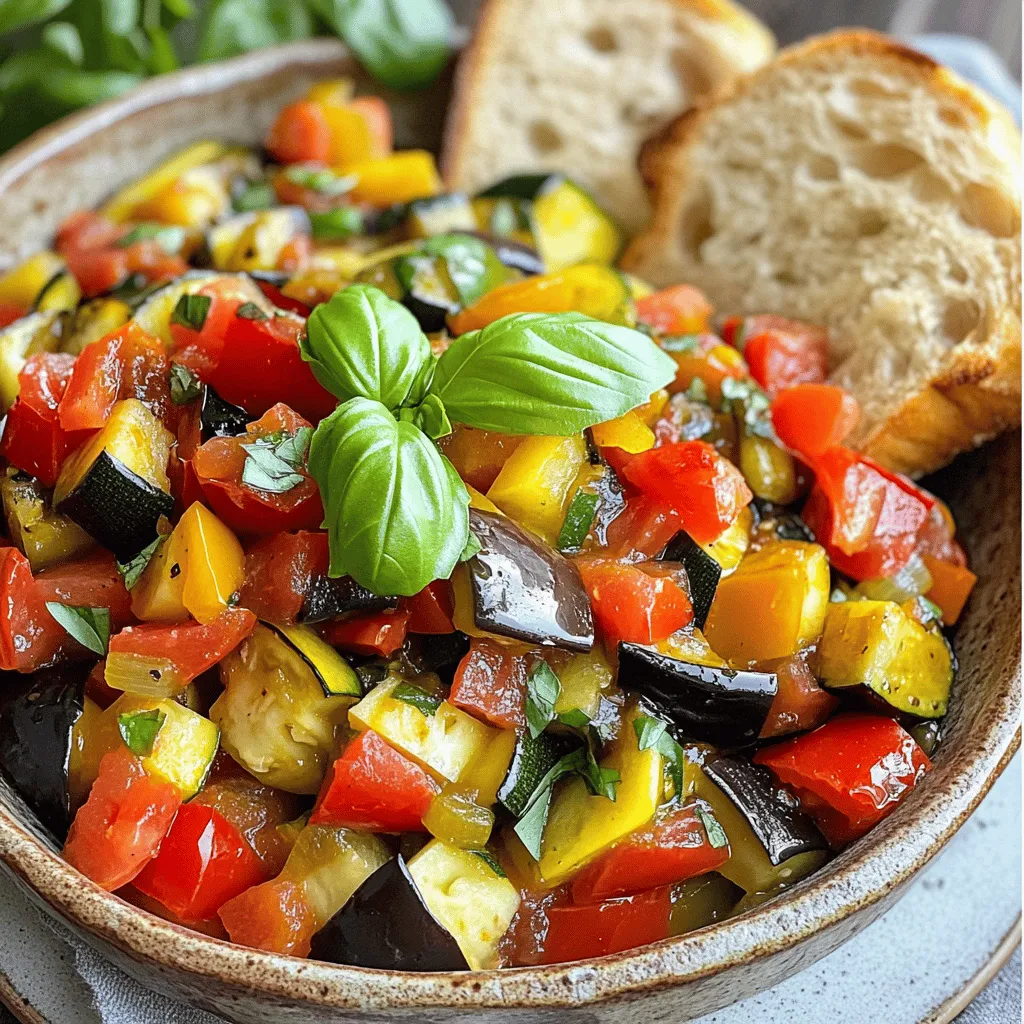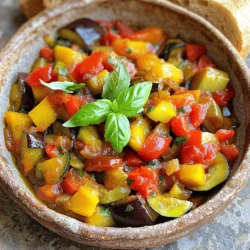Are you ready to dive into the vibrant world of Classic French Ratatouille? This dish combines fresh, colorful veggies and aromatic herbs for a mouthwatering experience. With simple steps and easy-to-find ingredients, you can recreate this time-honored dish at home. Whether you’re preparing it as a side or a main dish, you’ll impress everyone at your table. Let’s explore how to make this flavorful and easy recipe together!
Ingredients
Key Ingredients for Classic French Ratatouille
To make classic French ratatouille, you need fresh, colorful vegetables. Here are the main ingredients:
– 1 medium eggplant, diced
– 1 medium zucchini, sliced
– 1 bell pepper (red or yellow), chopped
– 1 onion, diced
– 2 cloves garlic, minced
– 2 cups ripe tomatoes, chopped (or 1 can of diced tomatoes)
– 1 tablespoon tomato paste
– 1 teaspoon dried thyme
– 1 teaspoon dried basil
– 1 teaspoon salt
– 1/2 teaspoon black pepper
– 3 tablespoons olive oil
– Fresh basil leaves for garnish
These veggies bring great flavor and texture. Eggplant gives a rich taste, while zucchini adds a nice crunch. Tomatoes add sweetness and acidity, making everything pop.
Fresh Herbs: Importance of Thyme and Basil
Herbs are key to great ratatouille. Thyme and basil give it a fragrant touch.
– Thyme adds an earthy flavor. It works well with the veggies and brings depth.
– Basil gives a fresh, bright taste. It is a classic herb in French cooking.
Using fresh herbs can elevate your dish. They can make the meal feel special and vibrant. You can add them near the end of cooking for the best flavor.
Optional Ingredients for Enhanced Flavor
You can boost the flavor of ratatouille with a few optional ingredients. Here are some ideas:
– Red pepper flakes for heat
– A splash of balsamic vinegar for tang
– Olives for a savory kick
Feel free to experiment with these extras. They can add your personal touch and make the dish unique. Ratatouille is all about using what you love!
Step-by-Step Instructions
Preparation: Chopping and Sautéing Basics
Start by gathering your ingredients. You need fresh vegetables for a bright flavor. Dice the onion and eggplant, slice the zucchini, and chop the bell pepper. Mince the garlic and chop the tomatoes if using fresh ones. Heat olive oil in a large skillet over medium heat. Add the diced onion first. Sauté it for about 3-4 minutes until it turns clear. Then, add minced garlic and cook for one more minute. This step builds a strong base for your dish.
Cooking Method: Building Flavors Layer by Layer
Next, stir in the chopped bell pepper. Cook it for another 5 minutes until it softens. Now, add the diced eggplant. Let it cook for about 5 minutes, stirring occasionally. Eggplant will soak up the oil and flavors. Then, add the sliced zucchini. Cook all the veggies together until tender, which takes roughly 5-7 minutes. This layering method helps each vegetable shine in the dish.
Simmering: Tips for Perfect Texture and Taste
Once your vegetables are tender, it’s time to add the tomatoes, tomato paste, thyme, basil, salt, and black pepper. Stir everything well to mix the flavors. Reduce heat to low and cover the skillet. Let the ratatouille simmer for about 30 minutes. Stir occasionally to prevent sticking. If you want a thicker texture, uncover the pot for the last 10 minutes. This simmering time allows the flavors to meld beautifully. Taste your dish and adjust seasoning if needed before serving.
Tips & Tricks
Best Practices for Choosing Vegetables
When making ratatouille, select fresh, ripe vegetables. Look for firm eggplants, bright zucchini, and colorful bell peppers. Fresh tomatoes enhance the dish’s flavor. Avoid any vegetables with soft spots. Choose seasonal produce for the best taste. Local farmers’ markets often have the freshest options.
Common Mistakes to Avoid When Making Ratatouille
Do not rush the cooking process. Each vegetable needs time to soften and release its flavors. Avoid overcooking; this can make the dish mushy. Use a large enough pan to allow for even cooking. Do not skip the herbs; they add essential flavor. Taste while cooking to adjust seasoning.
Serving Suggestions for Authentic Presentation
For an elegant touch, serve ratatouille in a shallow bowl. Garnish with fresh basil leaves to add color. Pair it with crusty bread for a rustic feel. You can also serve it with a drizzle of olive oil on top. This adds richness and enhances the dish’s taste.

Variations
Vegetarian Additions: How to Customize
Ratatouille is a great dish for adding your favorite veggies. You can swap or add vegetables easily. Here are some ideas:
– Mushrooms: Add sliced mushrooms for a rich flavor.
– Carrots: Grate or chop carrots for a sweet crunch.
– Spinach: Toss in fresh spinach for a pop of green.
Feel free to experiment! The best part about ratatouille is that you can make it your own. Just keep the basic cooking method the same.
Regional Twists on Classic Ratatouille
Different regions have their own takes on ratatouille. Here are a few interesting twists:
– Italian Style: Use Italian herbs like oregano and parsley. Add olives for a salty kick.
– Spanish Version: Mix in bell peppers and saffron. Serve with crusty bread or rice.
– Provençal Touch: In Provence, they often add more garlic and use fresh herbs straight from their gardens.
These regional styles show how versatile ratatouille can be. Each twist brings a new flavor to the classic dish.
Ratatouille as a Side Dish vs. Main Course
You can serve ratatouille in different ways. It works well as both a side dish and a main course.
– As a Side Dish: Pair it with grilled meats or fish. The fresh veggies complement the main dish nicely.
– As a Main Course: Serve it with bread or pasta. This makes it hearty and filling.
How you serve ratatouille really depends on your mood and meal. Enjoy it however you like!
Storage Info
How to Store Leftover Ratatouille
After enjoying your ratatouille, let it cool to room temperature. Use an airtight container to store any leftovers. Place the container in the fridge. Leftover ratatouille stays fresh for up to four days. Keep an eye on it. If it changes color or smell, it’s best to toss it.
Freezing Tips for Long-Term Storage
For long-term storage, freezing is a great option. First, let the ratatouille cool completely. Then, divide it into portions. Use freezer-safe bags or containers. Remove as much air as possible to prevent freezer burn. You can freeze ratatouille for up to three months. Label the containers with the date for easy tracking.
Reheating Ratatouille: Best Methods
When you’re ready to enjoy your ratatouille again, reheating it is easy. You can use the stove or microwave. For the stove, heat it in a pot over medium heat. Stir occasionally until warm. If using a microwave, place it in a bowl and cover. Heat for two to three minutes, stirring halfway through. Always check the temperature before serving. Enjoy it warm with fresh basil on top!
FAQs
What does traditional ratatouille taste like?
Traditional ratatouille has a rich, savory flavor. The mix of eggplant, zucchini, and bell peppers creates a sweet and earthy taste. Fresh herbs like thyme and basil add a fragrant touch. The tomatoes give it a nice acidity that balances the dish. Overall, it’s a warm and comforting dish that feels like a hug in a bowl.
Can I use other vegetables in ratatouille?
Yes, you can use other vegetables! Ratatouille is quite flexible. You might try adding mushrooms, carrots, or even squash. Just keep in mind that cooking times may vary. Make sure the veggies are cut to similar sizes for even cooking. Feel free to experiment with your favorites!
How long does homemade ratatouille last in the fridge?
Homemade ratatouille lasts about 4 to 5 days in the fridge. Store it in an airtight container for the best results. If you want it to last longer, consider freezing it. Frozen ratatouille can keep for up to 3 months. Just thaw it in the fridge before reheating.
Ratatouille is a simple yet tasty dish packed with veggies and flavor. We explored key ingredients, cooking steps, and tips to make it great. Remember to use fresh herbs for the best taste. Avoid common mistakes for perfect results. You can customize ratatouille to fit any meal. Store leftovers properly to enjoy later. Ratatouille is more than just a side—it can shine as a main dish. Embrace creativity in your cooking and enjoy this classic dish!


